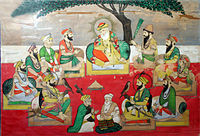คุรุซิกข์
คุรุซิกข์ (ปัญจาบ: ਸਿੱਖ ਗੁਰੂ; ฮินดี: सिख गुरु) เป็นศาสดาทางจิตวิญญาณของศาสนาซิกข์ผู้วางรากฐานศาสนาเป็นเวลาสองศตวรรษครึ่ง เริ่มต้นใน ค.ศ. 1469[2] โดย ค.ศ. 1469 เป็นปีเกิดของคุรุนานัก ผู้ก่อตั้งศาสนาซิกข์ ท่านมีผู้สืบทอดเป็นคุรุมนุษย์ 9 องค์ จนกระทั่งใน ค.ศ. 1708 ที่มีคุรุองค์ที่ 10 ส่งผ่านความเป็นคุรุไปยังคัมภีร์คุรุครันถสาหิพ ซึ่งปัจจุบันผู้นับถือศาสนาซิกข์ถือเป็นคุรุที่มีชีวิตอยู่[3] ความเป็นคุรุยังส่งผ่าน Guru Panth ซึ่งประกอบด้วยขาลสา แต่นั่นหมายความว่า ความเป็นคุรุเริ่มเข้าสู่จุดเสื่อมถอยหลังมหาราชา รณชีต สิงห์ขึ้นมามีอำนาจ[4][5]
รากศัพท์และคำนิยาม
คุรุ (สันสกฤต: गुरु; ปัญจาบ: ਗੁਰੂ, IAST: guru) เป็นศัพท์ภาษาสันสกฤตที่แปลว่า "ครู, ผู้ชี้นำ, ผู้เชี่ยวชาญ หรือบัณฑิต" ในความรู้หรือศาสตร์หนึ่ง[6] Bhai Vir Singh ระบุไว้ในพจนานุกรมของคุรุครันถสาหิพ ซึ่งกล่าวถึงคุรุเป็นการประสมหน่วยคำสองคำ: "คุ ; (ਗੁ)" หมายถึง ความมืด และ "รู ; (ਰੂ)" หมายถึง แสงสว่าง[7] ดังนั้น คุรุเป็นผู้นำแสงสว่างเข้ามาในความมืด หรืออีกนัยหนึ่งคือผู้ที่ให้ความสว่าง คำนิยามของ Bhai Vir Singh ระบุเพิ่มเติมเกี่ยวกับซิกขีเองและอธิบายว่าทำไมคุรุครันถสาหิพจึงถือเป็นคุรุที่ยังมีชีวิตอยู่ คำว่าซิกข์มาจากศัพท์ภาษาสันสกฤตว่า ศิษย์[8] (ปัญจาบ: ਸਿੱਖ) ซึ่งหมายถึงลูกศิษย์หรือนักเรียน ดังนั้น ชาวซิกข์จึงมีความสัมพันธ์แบบนักเรียน–ครูกับคุรุ เนื่องจากหลักคำสอนในคุรุครันถสาหิพนำหน้าที่เป็นแนวทางชี้นำแก่ชาวซิกข์
ตามความเชื่อของศาสนาซิกข์ คุรุทุกคนมีแสงหรือวิญญาณเหมือนกัน และร่างกายของพวกเขาเป็นสิ่งบรรจุแก่นสารเดียวกัน เมื่อคุรุคนหนึ่งเสียชีวิต ผู้สืบทอดจะสืบทอดแสงนั้น และนั่นคือเหตุผลที่คุรุจึงถูกเรียกเป็น mahalla (บ้าน)[9]
รายชื่อ
คุรุศาสดาประกอบด้วยคุรุมนุษย์ 10 ท่านและคุรุองค์ที่เป็น "อกาล" หรือเป็นนิรันดร์คือคุรุครันถสาหิพ หรือคือคัมภีร์ของศาสนาซิกข์ซึ่งแต่งตั้งโดยคุรุมนุษย์ท่านสุดท้ายคือคุรุโควินทสิงห์
- คุรุนานัก (Guru Nanak)
- คุรุอังคัต (Guru Angat) หรือ คุรุอังกัต, คุรุอังคัท, คุรุอังขัต, คุรุอังฆัต
- คุรุอมรทาส (Guru Amar Das) หรือ คุรุอามัร ดาส
- คุรุรามทาส (Guru Ram Das) หรือ คุรุรามดาส
- คุรุอรชุน (Guru Arjan) หรือ คุรุอรยัน, คุรุอาร์จัน
- คุรุหรโคพินท์ (Guru Har Gobind) หรือ คุรุฮัรโควินท์
- คุรุหรราย (Guru Har Rai) หรือ คุรุฮัรราย, คุรุหาร์ไร
- คุรุหรกิศัน (Guru Har Krishan) หรือ คุรุฮัรกฤษณ
- คุรุเตฆ์บะฮาดุร (Guru Tegh Bahadur) หรือ คุรุเตค บฮาดัร
- คุรุโควินทสิงห์ (Guru Gobind Singh) หรือ คุรุโควินท์สิงห์
- คุรุครันถสาหิพ (Guru Granth Sahib) หรือ คุรุครันถ์ซาฮิบ
เส้นเวลา

ครอบครัวต้นไม้

หมายเหตุ
- ↑ รายชื่อและความสัมพันธ์อาจมีความแตกต่างกันตามแหล่งข้อมูลต่าง ๆ เนื่องจากบุคคลต่าง ๆ มากมายตลอดระยะเวลาหกศตวรรษที่ผ่านมาร่วมกันเขียนประวัติศาสตร์ซิกข์ในด้านต่าง ๆ
อ้างอิง
- ↑ The Sikhs. E.J. Brill. p. 38. ISBN 9004095543.
- ↑ Sen, Sailendra (2013). A Textbook of Medieval Indian History. Primus Books. pp. 186–187. ISBN 978-9-38060-734-4.
- ↑ The Sikhs : faith, philosophy & folk. Lustre Press. 1998. ISBN 978-8174360373.
- ↑ McLeod, W. H. (24 July 2009). The A to Z of Sikhism. Scarecrow Press. pp. 84–86. ISBN 9780810863446.
Guru Gobind Singh is traditionally believed to have announced that the personal transmission would end at his death, but that the mystical Guru would remain embodied in the scripture and the corporate Panth. ... GURU PANTH. The Guru Panth was a doctrine particularly suited to the circumstances of the 18th century, providing an effective means of decision making for Sikhs who were divided into several misls. When unification was achieved under Ranjit Singh the practice of eliciting corporate decisions from the Panth was discarded. The doctrine is still maintained today, and efforts are occasionally made to seek the Guru's will by this means. It is, however, seldom invoked. The voice of the Guru is much more commonly sought through the words of the Guru Granth.
- ↑ "Sikh Reht Maryada - Other Rites and Conventions: Guru Panth (Panth's Status of Guruhood)". Shiromani Gurdwara Parbandhak Committee. สืบค้นเมื่อ 18 December 2024.
- ↑ Stefan Pertz (2013), The Guru in Me - Critical Perspectives on Management, GRIN Verlag, ISBN 978-3638749251, p. 2–3.
- ↑ Singh, Veer (1964). Sri Guru Granth Kosh. p. 122.
- ↑ Parrinder, Geoffrey (30 August 1983). World religions : from ancient history to the present. Facts on File. ISBN 978-0-87196-129-7.
- ↑ Grewal, J. S.; Habib, Irfan, บ.ก. (2001). Sikh History from Persian Sources: Translations of Major Texts. Indian History Congress. Session. New Delhi: Tulika. p. 5. ISBN 81-85229-17-1. OCLC 47024480.
The author of the Dabistan refers to the belief of the Sikhs in the unity of Guruship. The spirit of Guru Nanak entered the bodies of his successors - Guru Angad, Guru Amar Das, Guru Ram Das and Guru Arjan. That was why each Guru was referred to as mahal: Guru Nanak as the first mahal, Guru Angad as the second mahal, and in this way Guru Arjan as the fifth mahal. A Sikh who does not regard Guru Arjan as Baba Nanak is not a true Sikh. The firm belief of the Sikhs is that all the Gurus are Nanak. Indeed, Bhai Gurdas underscores the unity of Guruship from Guru Nanak to Guru Hargobind in one of his Vaars. This is reiterated in another Vaar in which the metaphors of light and water are used to emphasize that they all are the same.The idea of the unity of Guruship emphasized by Bhai Gurdas legitimized the succession of Guru Hargobind to face the rival claim of Prithi Chand and his descendants.


